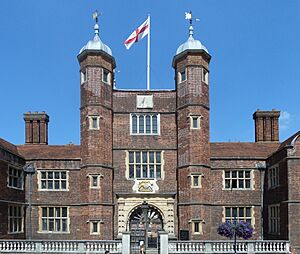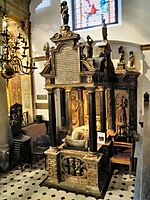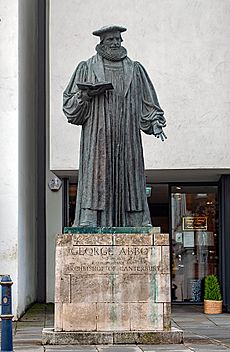George Abbot (bishop) facts for kids
Quick facts for kids The Most Reverend and Right Honourable George Abbot |
|
|---|---|
| Archbishop of Canterbury | |

Portrait in the National Portrait Gallery, 1623
|
|
| Church | Church of England |
| Diocese | Canterbury |
| Enthroned | 4 March 1611 |
| Reign ended | 4 August 1633 |
| Predecessor | Richard Bancroft |
| Successor | William Laud |
| Orders | |
| Consecration | 3 December 1609 by Richard Bancroft |
| Personal details | |
| Born | 29 October 1562 Guildford, Surrey, England |
| Died | 4 August 1633 (aged 70) Croydon, Surrey, England |
| Denomination | Anglican |
George Abbot (born 29 October 1562 – died 4 August 1633) was an important English church leader. He served as the Archbishop of Canterbury from 1611 to 1633. This was the highest position in the Church of England. He was also the head of the University of Dublin from 1612 to 1633.
People described him as a very religious person with strong beliefs. George Abbot had five brothers. One of them, Robert, became a bishop, and another, Maurice, became the Lord Mayor of London. George Abbot also helped translate the famous King James Version of the Bible.
Contents
Life and Career Highlights
Early Life and Education
George Abbot was born in Guildford, a town in Surrey, England. His father, Maurice Abbot, worked with cloth. George went to the Royal Grammar School, Guildford.
There's an old story about his birth. When his mother was expecting him, she dreamed that if she ate a pike fish, her child would be a boy and become very important. Soon after, she accidentally caught a pike while getting water from the River Wey. This story made some local gentlemen interested in the child, and they offered to support him.
George Abbot later studied and taught at Balliol College, Oxford. He worked with many important teachers. In 1597, he became the Master of University College. In 1600, he was made the Dean of Winchester. He also served three times as a top leader at the University.
Helping with the King James Bible
George Abbot played a big part in creating the official King James Version of the New Testament. This Bible translation is still very famous today.
In 1608, he traveled to Scotland with George Home, 1st Earl of Dunbar. Their goal was to help bring together the churches of England and Scotland. King James I was so impressed with Abbot's work that he made him a bishop. First, he became the Bishop of Lichfield and Coventry in 1609. Just a month later, he became the Bishop of London.

Becoming Archbishop of Canterbury
On 4 March 1611, George Abbot was promoted to the highest church position: Archbishop of Canterbury. In this role, he strongly defended the idea that Anglican bishops and priests had a proper, continuous line of authority from the early church.
He even invited some Roman Catholics to look at church records to prove this. Everyone agreed that the records were real and correct.
Challenges and Disagreements
Despite defending the church's traditions, Abbot was also very strict with Roman Catholics. He also bravely stood up to the king's wishes at times. For example, he disagreed with a royal divorce case involving Lady Frances Howard.
In 1618, he famously refused to allow the reading of the Declaration of Sports in churches. This document listed fun activities people were allowed to do on Sundays. Abbot believed Sundays should be kept for religious worship.
He supported the marriage of the king's daughter, Princess Elizabeth, to Frederick V. He strongly opposed the idea of the new Prince of Wales (who later became King Charles I) marrying a Spanish princess, Maria Anna. This made him unpopular with William Laud (another powerful church leader) and the king's court. However, King James himself always supported Abbot.
A Tragic Accident
In July 1621, while hunting deer in a park, an arrow from Abbot's crossbow accidentally hit one of the park keepers. The keeper died within an hour. This accident deeply upset Abbot, and he became very sad.
His opponents argued that this accident meant he could no longer be Archbishop. They said that even though it was an accident, hunting was not a proper activity for a church leader. King James asked a group of ten people to decide the matter. The group was split, so the King made the final decision, supporting Abbot. He even signed a special pardon for him.
It's interesting to note that George Abbot was both a translator of the 1611 King James Bible and the only Archbishop of Canterbury ever to accidentally cause a human death.

Later Years and Retirement
After the accident, the Archbishop rarely attended royal meetings because of his health. However, in 1625, he was with King James I during his final illness. He also performed the ceremony for the coronation of King Charles I.
In 1627, Abbot refused to approve a sermon that told people they must obey the king's demands without question. Because of this, King Charles I temporarily removed him from his duties as Archbishop. But soon, the king needed to call Parliament, and Abbot's powers were given back to him.
Since he was not welcome at court, Abbot lived quietly in retirement. This allowed William Laud and his supporters to gain more power. George Abbot died in Croydon on 4 August 1633. He was buried in his hometown of Guildford. There, he had set up Abbot's Hospital, a charity hospital, and given it land worth a lot of money each year.
Legacy and Remembrance
George Abbot was a dedicated church leader, though sometimes strict with those who disagreed with him. He wrote many books. One of his most interesting works was Exposition on the Prophet Jonah (1600). His book Geography, or a Brief Description of the Whole World (1599) was very popular and had many editions. A new edition was published in 2011 to mark 400 years since he became Archbishop.
Abbot had a huge personal library with over 8,000 books. Most of these he left to Lambeth Palace Library. You can still find books with his special stamp in libraries today.
Guildford remembers Archbishop Abbot with his hospital and a statue on the High Street. A secondary school and a pub in the High Street are also named after him. His tomb can be found in Holy Trinity Church.
Images for kids






